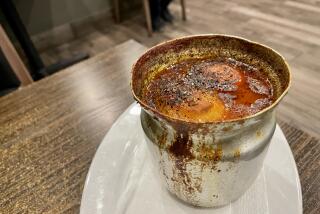GARDEN FRESH : Mizuna: The Next Arugula
- Share via
Beauty is in the beholder’s eye, and sometimes in the mouth. What joy when it’s in both! This was never more so than in the venerable Asian mustard, mizuna.
Mizuna’s glossy leaves are dark-green faced with silvery white. Stalks--long as a peacock’s feather--are water-green and reed-slender. Mizuna grows in a rosette of a mound that might be young lace-leaf maples or hart’s-tongue ferns. In the kitchen, when a few mizuna are heaped on a lustrous old towel, I half-close my eyes and imagine them brushed on a glazed bowl or embroidered in silk. The mustard has been cultivated for so many centuries in Japan that in the rest of Asia, the vegetable is regarded as Japanese. Another Japanese name for mizuna is kyona-- greens from Kyoto, the ancient capital of the empire. Mizuna translates from the Japanese as water or juicy vegetable.
As for the eating, mizuna’s flavor could be hot and coarse. Most mustards are. Mizuna’s texture could be fibrous. Most mustards are. But the lacy leaves taste tangy--rather a blend of spinach, mustard and sorrel shoots--with an underlying sweetness. The stalks are also sweet, tender and crisp. And when the plant begins producing seeds, the flowers, too, are sweet.
In my experience, no other mustard is as pleasing to the eye and to the palate. Peacock kales are rivals in form, but the tenderest is not comparable in either texture or flavor.
You can have mizuna in the garden the year-round. Although mizuna prefers cool weather, it is extremely tolerant of heat, cold and rain. It won’t go to seed in 90-degree summers, and in a cold frame the leaves have been harvested through sub-freezing winters.
If you sow mizuna in spring’s cool, you can begin picking leaves in four to six weeks. Sown in autumn in temperate climates, the seedlings may grow more slowly, but they will grow through winter and into spring. Mizuna is biennial, so it’s not supposed to go to seed until the second year. But mustards have a mind of their own, and it may send up flowers in April if sown in autumn. After flowering, the leaves do become hot and chewy.
To sow mizuna for winter where it’s cold, take a calendar and count back two months and two weeks before the first expected frost, and sow seeds where they’ll grow during that period. They’ll be lushest under the shelter of a cold frame.
Mustards do best in light, moisture-retentive soil--amend clay with organic matter such as old straw (lug it in garbage bags from a stable) and compost. You may want to fling a handful of blood meal over the soil and fork it in. Thin seedlings to about nine inches apart in spring and six inches apart for wintering over. Give full sun and water to keep the roots moist.
Mizuna has no pests to speak of past the basic hungry slugs and sometimes flea beetles. A floating row cover will hide mizuna’s beauty but protect it from beetles, if they’re bad. I had no beetles but my first plant did suffer a bout with mildew. You can usually prevent mildew by not watering the plant’s leaves but irrigating the ground and by assuring good air circulation--I’d set mine in a corner close to the house. So place your mizunas in the open. And when you place them, since you can harvest tender leaves from a plant as long as 10 months or so, let three to four years pass before you return mizunas to the same place (this inhibits soil-born problems).
If your mizuna needn’t be under cover, its featheriness is delightful combined with the small white daisies of feverfew--especially the sort with chartreuse leaves, the golden buttons of tansy, or fine daisies of German chamomile--all have an airy appearance.
You can harvest leaves at any stage--younger leaves are the more tender and mild, of course. To harvest, treat the plant as a cut-and-come-again: Use scissors or a knife to cut leaves at the base from the outside of the plant in, or cut a whole small head, leaving the roots so new shoots will come. Pick leaves continually and fresh ones will grow.
In Japan, mizuna is often pickled. The leafy parts are salted and finely chopped, then stirred into rice. Stalk pieces are steeped in salt, sugar and rice vinegar for a day or two, then served as a nibble with cold beer.
My favorite use of these elegant leaves is in salads--you too will never tire of finding them amid the lettuces and more mundane whatnots. Remember that eating leaves with your fingers adds immeasurably to the pleasure.
In cooking, as with nearly every leafy green, it’s wise to pull the leaves from the stalks and ribs and cook each separately. One will invariably cook faster than the other, and you may not know which will do which. Mizuna is lovely in stir-fries, even though I hate wilting the leaves. And, of course, you can adapt most any mustard greens or cabbage recipe to mizuna.
But because the plants are so generous, the time comes when your thoughts turn to soup. Mine did. Rather than a Japanese-style soup, I swirled in a couple of tart elements to enhance the tangy quality of the leaves.
For a traditional mizuna soup, compose a broth of dashi (stock base available in the Asian section of most markets), low-salt soy sauce (use a light hand with this) and a splash of sake (any dry white wine will do). Slice the green part of the mizuna leaves into thin ribbons, steam until barely tender, then stir into the hot broth. For contrasting color and texture, add slivers of lemon zest and strands of cooked somen noodles (thin white noodles made from wheat flour, available with the dashi ).
I suppose it was only a matter of time before this noble leaf was discovered by the restaurant world. As we speak, it’s being stuffed into ravioli and speckled through cream sauces, and if we don’t watch out, one of these days there will probably be mizuna coulis and mizuna sorbet. Mizuna already shows up on focaccia here in Los Angeles. A prescient friend says mizuna may be the next arugula--saints preserve us. Does that mean mizuna will soon sell for a fortune?
Then you can’t sow your seeds fast enough!
Sources:
Fresh--Most Asian markets.
Seeds of mizuna and floating row covers--Johnny’s Selected Seeds, Foss Hill Road, Albion, Me. 04910-9731. Seeds of feverfew (‘Aureum’), tansy and chamomile--Richters, Goodwood, Ontario, Canada LOC 1A0.
*
If you must wait a bit for your mizuna leaves, you can have a hint of their flavor in this recipe by mixing half romaine lettuce leaves with the youngest mustard greens you can find. To enjoy with this lovely green soup, I like rich cheeses, such as aged Cheddar and fresh goat’s milk; the crispness of crackers, such as lavosh with sesame seeds; juicy purple plums or green apples; maybe ginger-flavored cookie or cake, and Chinese or Japanese beer.
MIZUNA SOUP, SUMMER AND WINTER 6 ounces mizuna 1/2 white onion, finely chopped 1 tablespoon oil 3 cups water 1/4 cup sour cream or yogurt 1 tablespoon fresh lemon juice Salt Freshly ground white pepper 4 small whole fresh mizuna leaves
Strip leaves from stalks by folding leaf in half lengthwise, then holding stalk while gently pulling greens from spine from top down. Chop stalks. There should be about 4 firmly packed cups greens and 1 cup stalks.
In saucepan saute onion in oil over medium-high heat until tender, 2 to 3 minutes. Add stalks and water. Cover, bring to simmer, turn heat to low and simmer 10 minutes. Add greens and cook 5 minutes more.
Puree mixture in blender, food processor, or through food mill. Whisk in sour cream and lemon juice. Season to taste with salt and white pepper. Serve hot or chilled. Soup may be prepared few hours in advance. Float fresh mizuna leaf atop each bowl. Makes about 4 servings.
Each serving contains about: 87 calories; 100 mg sodium; 6 mg cholesterol; 7 grams fat; 6 grams carbohydrates; 2 grams protein; 0.69 grams fiber.






